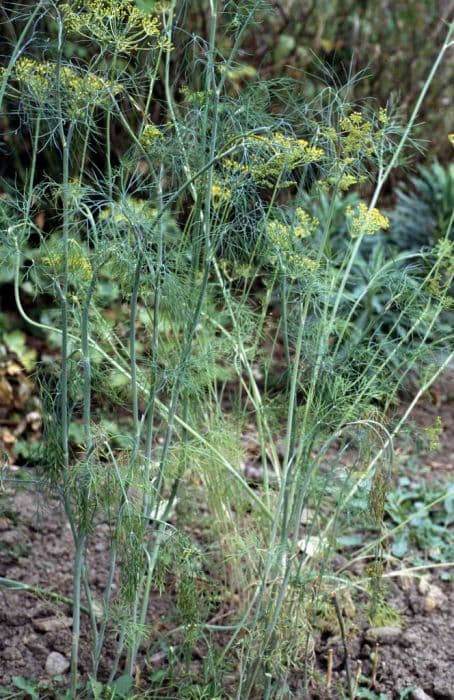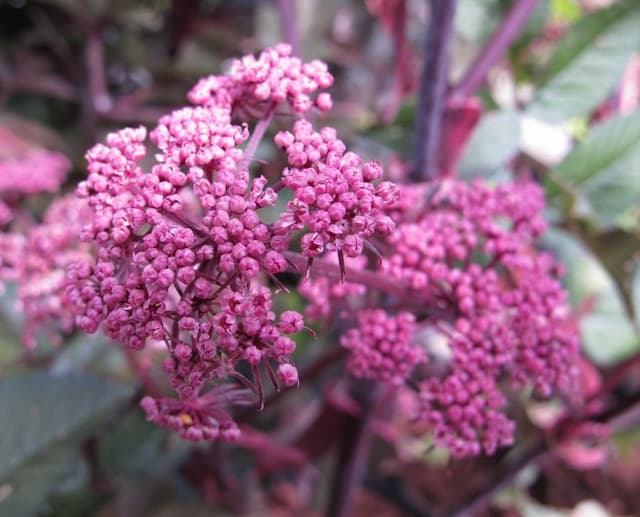Parsley Petroselinum crispum

ABOUT
Petroselinum crispum, commonly known as parsley, is a bright green herb that is widely used in culinary applications for its fresh, aromatic flavor. This plant characteristically has ruffled or curly leaves that are deeply divided into oval shapes with pointed tips. The leaves are arranged in a rosette around the stem, creating a bushy and lush appearance. The texture of the leaves is somewhat delicate to the touch, yet they are hardy enough to hold up when mixed into dishes. During its growth, parsley can produce small, umbrella-shaped clusters of tiny flowers that are typically yellow-green to greenish-white. These flowers bloom atop thin, grooved stalks which arise from among the curly foliage. The overall appearance of parsley is quite ornamental, which makes it not only a favored garnish for its bright color and fresh taste but also an attractive addition to gardens and window sills.
About this plant
 Names
NamesFamily
Apiaceae.
Synonyms
Parsley, Garden Parsley, Common Parsley, Curled Parsley.
Common names
Apium crispum, Apium petroselinum, Carum petroselinum, Petroselinum hortense, Petroselinum sativum.
 Toxicity
ToxicityTo humans
Parsley (Petroselinum crispum) is generally not toxic to humans when consumed in typical culinary amounts. However, it can become toxic if consumed in extremely large quantities. Parsley contains furanocoumarins and psoralens, which can cause photosensitization and skin reactions in sensitive individuals when exposed to sunlight. Ingesting large amounts can also have adverse effects due to its high levels of apiol and myristicin, which can lead to symptoms like nausea, vomiting, diarrhea, abdominal pain, and, in severe cases, seizures or arrhythmias. Pregnant women should avoid excessive consumption since apiol has been associated with uterine contractions and can potentially lead to miscarriage.
To pets
Parsley is generally considered non-toxic to pets such as dogs and cats when ingested in small, reasonable amounts occasionally found in foods. However, similar to humans, high doses could potentially lead to digestive upset, including vomiting and diarrhea due to the essential oils and furanocoumarins it contains. While it is not among the most dangerous plants for pets, it is advisable to avoid offering large quantities to prevent any potential adverse effects. Always consult with a veterinarian before introducing new foods or herbs into your pet's diet.
 Characteristics
CharacteristicsLife cycle
Biennials
Foliage type
Evergreen
Color of leaves
Green
Flower color
Yellow
Height
1 foot (30 cm)
Spread
1 foot (30 cm)
Plant type
Herb
Hardiness zones
5
Native area
Mediterranean
Benefits
 General Benefits
General Benefits- Culinary Uses: Petroselinum crispum, commonly known as parsley, is widely used as a herb, spice, and vegetable in various cuisines around the world to enhance the flavor of dishes.
- Nutritional Content: Parsley is a good source of vitamins A, C, and K, as well as several minerals like iron and potassium.
- Garnishing: It can be used to garnish and decorate food, enhancing the visual appeal of dishes.
- Aromatherapy: The essential oil derived from parsley is sometimes used in aromatherapy for its perceived therapeutic properties.
- Herbal Teas: Parsley can be used to make herbal teas, which are consumed for their pleasant taste.
- Garden Aesthetics: Parsley, with its vibrant green leaves, can be grown in gardens or pots for its ornamental value.
- Culinary Variety: Parsley can be used in various forms such as fresh, dried, or as a powdered spice, adding versatility in cooking.
- Companion Planting: When grown in gardens, parsley can be beneficial in companion planting, as it may help to deter some harmful pests from other plants.
 Medical Properties
Medical Properties- Diuretic effects: Parsley (Petroselinum crispum) is traditionally used to increase urine production which can help in flushing out the kidneys.
- Rich in antioxidants: It contains high levels of flavonoids and vitamin C, which have antioxidant properties and may support the immune system.
- Antimicrobial activity: Essential oils in parsley have been shown to have some antibacterial and antifungal effects.
- Gastrointestinal health: Parsley has been used in traditional medicine to aid in digestion and to help relieve gastric distress such as flatulence and bloating.
- Vitamin K content: High in vitamin K, it can contribute to bone health and proper blood clotting. However, this nutritional aspect is not considered a direct medical treatment.
- Menstrual flow regulation: Historically, parsley has been used to help regulate menstrual flow and ease cramps.
 Air-purifying Qualities
Air-purifying QualitiesThis plant is not specifically known for air purifying qualities.
 Other Uses
Other Uses- Pets: Parsley can be safe in small amounts for pets like rabbits and guinea pigs, providing them with vitamins and freshening their breath.
- Natural Dye: Parsley can be used to create a natural green dye for fabrics and yarns.
- Decorative: Parsley is used as a garnish not only for its flavor but also to add a decorative touch to various dishes.
- Odor Neutralizer: Chewing parsley can help neutralize strong mouth odors, especially after eating foods like garlic or onions.
- Anti-Fog Agent: Rubbing parsley leaves on the inside of goggles or windows can help prevent them from fogging up.
- Deodorizer: Placing a small bunch of parsley in a room can act as a natural deodorizer, absorbing some of the odors in the air.
- Plant Companion: Parsley is believed to enhance the growth and flavor of tomato plants when grown nearby in a garden.
- Funerary Symbolism: In some cultures, parsley is used in funerary rites and placed on graves as a symbol of comfort for the departed.
- Flower Arrangements: Parsley’s vibrant green foliage can be used in flower arrangements to provide contrast and fullness.
- Crafts: Parsley stems can be woven or braided into small wreaths or decorative crafts for a rustic, natural look.
Interesting Facts
 Feng Shui
Feng ShuiParsley is not used in Feng Shui practice.
 Zodiac Sign Compitability
Zodiac Sign CompitabilityParsley is not used in astrology practice.
 Plant Symbolism
Plant Symbolism- Protection: Parsley is often associated with protection and purification, it was used in ancient times to ward off evil spirits and negative energies.
- Festivity and Joy: In the Roman era, parsley wreaths were used to adorn victors, making it a symbol of celebration and success.
- Death and Mourning: Parsley has been connected to death due to its slow germination rate, leading to a superstition that it travels to the devil and back before sprouting. It is sometimes placed on graves in the belief it will bring peace to the deceased.
- Health and Wellness: Due to its rich vitamin and mineral content, parsley is associated with good health and was used historically as a medicinal herb.
 Water
WaterParsley (Petroselinum crispum) should be watered thoroughly, allowing water to soak into the soil reaching the roots without flooding the plant. In general, watering should occur when the top inch of soil feels dry to the touch, which could be about once per week, depending on climate conditions. It is important to provide parsley with approximately one to two gallons of water every seven days during active growing seasons, ensuring consistent soil moisture levels. Over-watering or allowing the soil to stay soggy can lead to root rot, so good drainage is essential. During hotter, drier periods, you might need to water parsley more frequently to maintain proper soil moisture.
 Light
LightParsley prefers full to partial sunlight conditions, thriving best with around six to eight hours of direct sunlight each day. It's best to place it in a sunny spot where it can receive ample light without being exposed to the harsh midday sun, which can sometimes be too intense. Morning sun with afternoon shade often works well, especially in hotter climates.
 Temperature
TemperatureParsley fares well in temperate climates and can survive in temperatures as low as 10 degrees Fahrenheit but grows best when temperatures are between 50 and 70 degrees Fahrenheit. It can be sensitive to extreme heat, so when temperatures start rising above 85 degrees Fahrenheit, it's crucial to provide some shade to protect the plant.
 Pruning
PruningPruning parsley stimulates new growth and prevents the plant from becoming leggy. Trim the outer stems regularly, especially when they are tall enough for harvest, which often coincides with weekly meal preparation times. The best time for more extensive pruning is in late winter or early spring, before the onset of new growth, but regular trimming can occur throughout the growing season as needed.
 Cleaning
CleaningAs needed
 Soil
SoilParsley (Petroselinum crispum) thrives in a well-draining, loamy soil mix with a pH between 6.0 and 7.0. An ideal soil mix could include equal parts of garden soil, compost, and perlite to ensure good drainage and fertility. Adjust the pH if necessary using lime to increase pH or sulfur to decrease pH to meet these conditions.
 Repotting
RepottingParsley typically does not require frequent repotting and can be sown annually. If growing in pots, repot every other year or when the plant becomes root-bound. Parsley is a biennial plant and will often complete its lifecycle within two years, making repotting less of a concern compared to perennial plants.
 Humidity & Misting
Humidity & MistingParsley prefers moderate humidity levels but is quite adaptable and can tolerate the average humidity found in most homes. It does not require a specific humidity level to thrive, so there is no need to adjust the ambient humidity for parsley.
 Suitable locations
Suitable locationsIndoor
For indoor parsley, place in bright light and keep soil moist.
Outdoor
Grow parsley in full sun to partial shade; keep soil consistently moist.
Hardiness zone
Parsley is suitable for USDA zones 5-9.
 Life cycle
Life cyclePetroselinum crispum, commonly known as parsley, begins its life as a seed that germinates under suitable conditions of warmth and moisture, usually in the spring. Upon sprouting, it develops a rosette of leaves that grow at the base during the vegetative stage, which can last for several weeks to a few months. Throughout the first year, the plant focuses on leaf production, which is later harvested for culinary use. If allowed to overwinter, parsley will enter its second year where it shifts energy to flowering, producing tall stems with umbels of small flowers that can attract beneficial insects. Following pollination, seeds form and, when mature, are dispersed to start a new generation. Parsley is a biennial plant, completing its life cycle in two years before dying.
 Propogation
PropogationPropogation time
Spring to early summer
Propogation: The most popular method of propagating Petroselinum crispum, commonly known as parsley, is by seeding. Parsley seeds are typically sown in early spring, around late March or early April, when the soil temperature is at least 50°F (10°C). Before planting, seeds may benefit from being soaked in warm water for 24 hours to help break dormancy and encourage germination. Sow the seeds shallowly, about 1/8 inch deep (3 mm), in well-drained soil, spacing them approximately 6 inches (15 cm) apart. Parsley seeds can take several weeks to germinate, and it is important to keep the soil consistently moist during this time. Once the seedlings have sprouted and grown strong enough, they can be thinned out or transplanted to their final growing positions.









